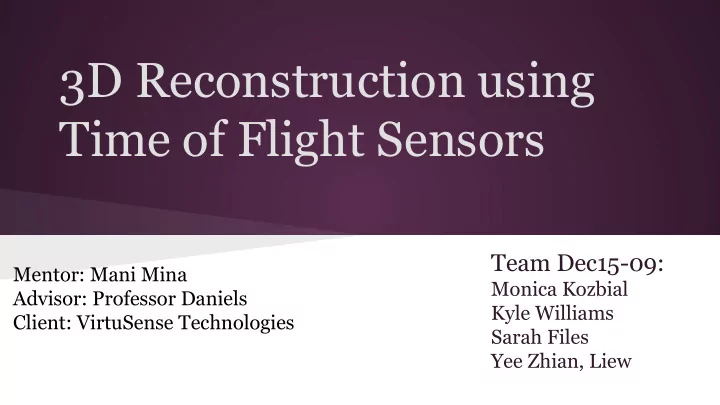

3D Reconstruction using Time of Flight Sensors Team Dec15-09: Mentor: Mani Mina Monica Kozbial Advisor: Professor Daniels Kyle Williams Client: VirtuSense Technologies Sarah Files Yee Zhian, Liew
Overview - VirtuSense Technologies - Project Summary & Market study - Project Phases - Current Progress - Project Detail - Challenges - For Next Semester
● Markets innovative solutions to healthcare providers including: VirtuOR: Monitors the operating room to determine how ○ time can be better used VirtuBalance: Provides data to reduce risk of fall for ○ patients DyST: Analyzes athlete performance and provides ○ feedback
Project Summary ● Requested by VirtuSense Technologies ● Target User: Cosmetic Surgeons ● Simulates the effect of cosmetic procedures on a patient’s face ● Utilizes the Kinect version 2.0 “time of flight” sensors Market Research: ● The market in 3D modeling is expected to be adopted into the medical area
Project Phase Overview Three Phases: - Phase 1: Capture the Model - Phase 2: Edit in Blender - Phase 3 (Stretch Goal): Full Body Scan
Phase 1: High Quality Model Use Kinect 2.0 for Windows 8 to create a 3D model -Capture the subject’s face and convert to a 3D model -Apply texture overlay -Export to Blender Deliverables 1. Converting 3D models to 3D meshes 2. Smoothing algorithms for 3D meshes 3. Texture overlay on the 3D models
Phase 2: Edit in Blender Once the 3D Model is in Blender, create a user friendly UI for manipulation -Create an add-on that limits tools to the essentials -Develop 3D morphing algorithms to manipulate any selected meshes on model Deliverables 4. UI for manipulating 3D models 5. UI for selecting individual regions from a 3D model 6. Algorithms for 3D morphing both on meshes and textures
Phase 3 (Stretch Goal) Scale Phase 1 to allow full body scans -Instead of just the face, create 3D model from entire body -Only if enough time after Phase 1 and 2 Deliverables 7. Geometry calculations for locating sensors for whole body capture 8. Algorithms for 3D morphing on selected regions on the whole body
Current Progress Currently in Phase 1: - UI design - Texture mapping - FaceModelBuilder and HDFace - Improving Model - Kinect sensor pipeline
Kinect User Interface ● Web Application ● Responsive web page ● Works with Kinect to capture model ● Local Program, no internet required ● Export captured 3D model to Blender
Kinect Version 2.0 Sensor Time-of-flight Technology
System Specifications ● Windows 8/8.1 ● 64 bit (x64) processor ● 4 GB Memory (or more) ● i7 3.1 GHz (or higher) ● Built-in USB 3.0 host controller ● DX11 capable graphics adapter
KinectFusion ● Maximum Integration Weight ○ controls the temporal averaging of data into the reconstruction volume ● Depth Threshold ○ determines the region of the reconstion volume ● Volume Voxels per Meter ○ scales the size that a voxel represents in the real world
Smoothing Attempts
Early Parameter Testing (left) vs Recent Parameter Testing (right)
Intel HD Graphics Family (left) vs Nvidia GeForce GT 525M (right)
Scanned model with color mapping
HD Face Face capturing in kinect ● captures the face in 16 frames (splits into 4 regions) ● Takes 94 vectors from these regions to apply to average face ● Create the mesh and apply it to other applications
Next Semester’s Goals Spring Semester ‘15 Fall Semester ‘15 ● Hardware setup ● Complete Phase 1 ● Collect data with Kinect ○ Finish refining Kinect SDK SDK capture parameters ● Research algorithms to Finish implementation and ○ smooth models Kinect UI ● Create UI Screen sketches ● Phase 2 and web application DOM ○ UI is integrated with Blender Select parts of the model within ○ Blender ○ Apply modification algorithms
Questions?
Challenges ● Research (small area of study, limited resources) ● Blender Licensing ● Limiting Hardware/Software Requirements ○ Windows 8/ USB 3.0 ○ Graphics Card ● Slow response time for resources (lab space, Kinect- ready computer, repositories, etc) ● Understanding Kinect parameters with few resources
Process Diagram Overview
Blender Licensing ● Blender has a GNU General Public License ● A plug-in made for Blender normally must follow the GNU GPL license. ● “Only if the plug-in doesn’t work within Blender as ‘acting as a single program’ (like using fork or pipe; by only transferring data and not using each others program code) you have the full freedom to license the plug-in as you wish.” (https://www.blender. org/support/faq/)
“Time-of-Flight” Camera A time of flight camera is a range imaging camera system that resolves distance based on the known speed of light, measuring the time of flight of a light signal between the camera and the subject for each point of the image.
Kinect Fusion Pipeline
Iterative Closest Point (ICP) Iterative closest point finds the rotation and movement that best aligns two point clouds.
Recommend
More recommend